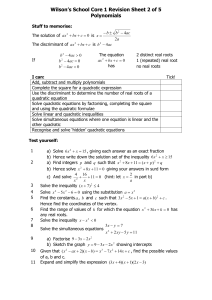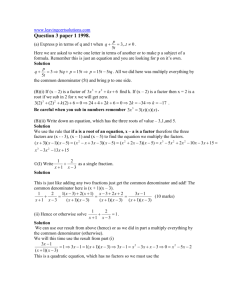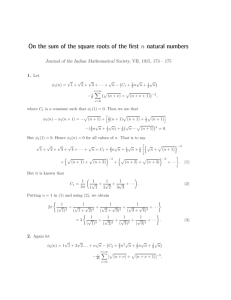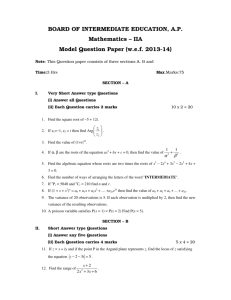Maths Higher Level Paper 1
advertisement
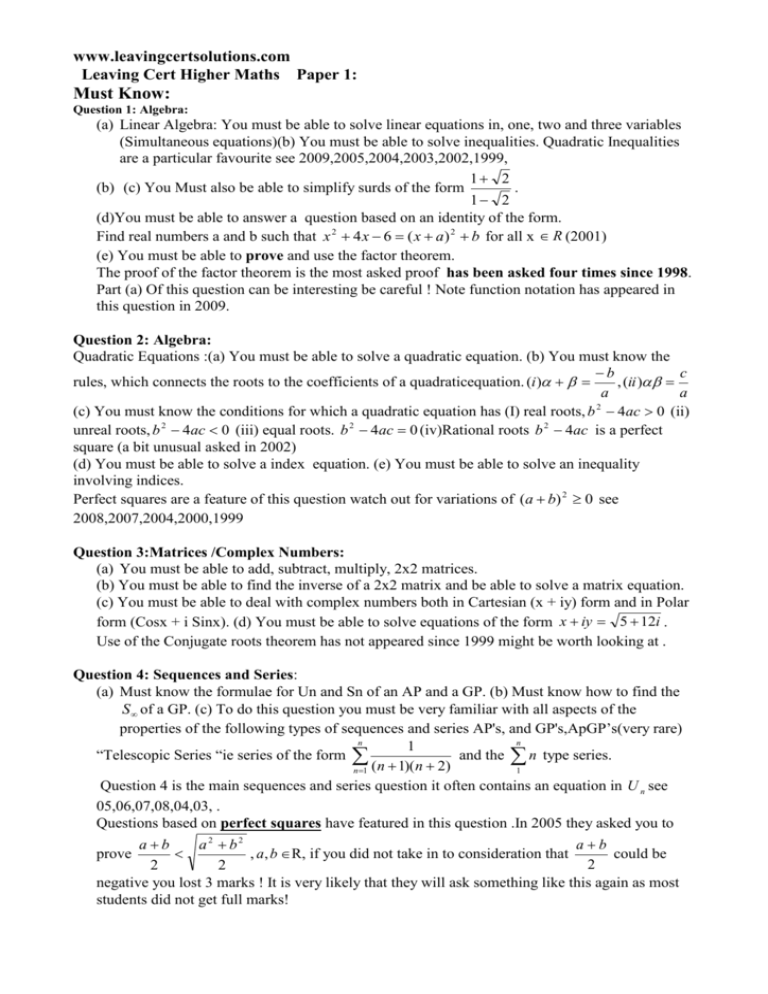
www.leavingcertsolutions.com Leaving Cert Higher Maths Paper 1: Must Know: Question 1: Algebra: (a) Linear Algebra: You must be able to solve linear equations in, one, two and three variables (Simultaneous equations)(b) You must be able to solve inequalities. Quadratic Inequalities are a particular favourite see 2009,2005,2004,2003,2002,1999, 1 2 (b) (c) You Must also be able to simplify surds of the form . 1 2 (d)You must be able to answer a question based on an identity of the form. Find real numbers a and b such that x 2 4 x 6 ( x a) 2 b for all x R (2001) (e) You must be able to prove and use the factor theorem. The proof of the factor theorem is the most asked proof has been asked four times since 1998. Part (a) Of this question can be interesting be careful ! Note function notation has appeared in this question in 2009. Question 2: Algebra: Quadratic Equations :(a) You must be able to solve a quadratic equation. (b) You must know the b c , (ii ) rules, which connects the roots to the coefficients of a quadraticequation. (i ) a a 2 (c) You must know the conditions for which a quadratic equation has (I) real roots, b 4ac 0 (ii) unreal roots, b 2 4ac 0 (iii) equal roots. b 2 4ac 0 (iv)Rational roots b 2 4ac is a perfect square (a bit unusual asked in 2002) (d) You must be able to solve a index equation. (e) You must be able to solve an inequality involving indices. Perfect squares are a feature of this question watch out for variations of (a b) 2 0 see 2008,2007,2004,2000,1999 Question 3:Matrices /Complex Numbers: (a) You must be able to add, subtract, multiply, 2x2 matrices. (b) You must be able to find the inverse of a 2x2 matrix and be able to solve a matrix equation. (c) You must be able to deal with complex numbers both in Cartesian (x + iy) form and in Polar form (Cosx + i Sinx). (d) You must be able to solve equations of the form x iy 5 12i . Use of the Conjugate roots theorem has not appeared since 1999 might be worth looking at . Question 4: Sequences and Series: (a) Must know the formulae for Un and Sn of an AP and a GP. (b) Must know how to find the S of a GP. (c) To do this question you must be very familiar with all aspects of the properties of the following types of sequences and series AP's, and GP's,ApGP’s(very rare) n n 1 “Telescopic Series “ie series of the form and the n type series. n 1 ( n 1)( n 2) 1 Question 4 is the main sequences and series question it often contains an equation in U n see 05,06,07,08,04,03, . Questions based on perfect squares have featured in this question .In 2005 they asked you to ab a2 b2 ab , a, b R, if you did not take in to consideration that could be 2 2 2 negative you lost 3 marks ! It is very likely that they will ask something like this again as most students did not get full marks! prove Question 5: Series /Induction/Logs: (a) You must be able to prove all of the following by Induction (i) Sums of Series such as n n(n 1) n n(2n 1)( n 1) 1 n 2 , 1 n 2 6 n 2 (ii) Inequalities of the form 2 n , n 4 ,and n! 2 n , n N , n 4 (iii) That a given number is a factor of a given expression; Prove by Induction that 7 2 n 1 1 is divisible by 8. Use the link to download notes on induction (b) http://www.leavingcertsolutions.com/mall/leavingcertsolutions/pdf/Induction_Higher_maths _p1_leaving.pdf (c) must be able to solve equations involving Logs. (d) You must be able to use the Binomial expansion, you must be able to use the general term to find specific terms, and you must know the properties of Binomial Coefficients. Question 6: Differential Calculus: (a) You must be able to differentiate functions using the product, quotient, and chain rules (b) You must be able to differentiate implicit functions. (c) You must be able to use calculus to find the turning points on a curve. To show that a given function is increasing/decreasing (d) You must be able to find the Asymptotes and sketch the graph of functions of the ax b form f ( x) . cx d Question 7: Differential Calculus: (a) You must be able to differentiate the following functions from first principals 1 x 2 , x 3 , , x , sin x, cos x (can appear in Q6orQ7)You must also be able to derive the Sum Rule x u y u v ,Product rule ( y uv )and the Quotient rule y from first principles.Note the v f ( x h) f ( x ) lim method works well in most cases but you should use the x method for the h 0 h product and quotient rules (see attached notes) (b) You must be able to use calculus to solve problems involving distance, speed, time and rate of change problems in general(not very common) . © You must be able to differentiate functions in parametric form. Parametric differentiation is one of the questions that is used to sort out the A students from the rest! You must be able to differentiate Implicit Functions. (d) The Newton Rapson method for finding the roots of equations has been a particular favourite in this question in recent years.this question was very badly attempted in 2005 . Question 8: Integral Calculus: (a) You must be able to integrate standard integrals (b) You must be able to use substitutions in particular the udu substitution.Trig Integrals are particularly popular pay special attention to all of the following 2 2 Sinkxdx, Sinkx Sinlxdx, Sin xdx, Cos xdx . You must also be able evaluate all of the following. dx x dx 1 bx dx 1 x dx 1 bx Sin 1 , Sin 1 , 2 Tan 1 , 2 Tan 1 2 2 2 2 2 2 a b a a x a a a b x ab a a x a b x 2 You must be able to use integration to find(i) the Area under a curve (ii) the volume formed by rotating the graph of a function about an axis (objects formed can only be cones or spheres). (d) The last part of this question may be quite difficult be well prepared. General Comments: (a) The marking scheme is as follows* (i) each question is broken into three parts a = 10 marks, b = 20 marks, c = 20 marks. (ii) Attempt marks will be awarded for any step in the right direction (iii) Errors are marked as follows, - 1 for a slip a small arithmetical error, -3 for a blunder a technical error. (iv) The same mistake is never punished more than once ie you cannot lose marks more that once for a repeated error. (v) The order in which the questions are attempted is not important. For some students the best advice is to do all the part a and b’s first then come back and do the more difficult part c's. (b) *Change in Marking Scheme in 2005. There was a change in the marking scheme in 2005 (Q 6 Paper 1) Where the inspector decided that certain questions were not to be marked using slips and blunders but that only particular marks (decided by him) could be awarded, the affect was to punish the better students but to help the middle ranking students. Proofs on this paper (1) Factor theorem (2) Induction (3) The Calculus proofs from first principals I do not like to give tips but first principals seems to be popular with the examiners the ones that have not been asked so far are y = Cosx, y x .... y u . v Last year many students made a total mess of Question 7 c it might get another run this year in a more simple form Question 8 for the last two years has had a difficult part c it would be a good idea to have a question in reserve just in case this goes badly for you !. Since most students do Questions 1,2,3,6,7,8, these questions are often used to sort out the A grades from the B grades notice that the most difficult part c’s have been in the six most popular questions ! . For the moment the two easiest questions on the first paper are questions 4 and 5 . A couple of hours work on Questions 4 or 5 will bring great rewards . Possible Questions for 2011 2003 - 2010were the first exams set by The Examinations Commission therefore it is worth while paying a bit of attention to what was asked in those years. Points to note (1)Nearly every question consisted of 5 parts. All part C’s had a least 2 parts in some cases not related to each other.They seem to love perfect squares asked in 2003/2004/2005/2008/2009 (2) The following questions should be looked at 2c, 4c, and 7c. Essential for All Leaving Cert Higher Maths Students! Leaving Cert Higher Maths solutions 2000-2010 by John Brennan The solutions book with all the solutions from 1998-2010 price €25 +P&P . A must for all Leaving Cert Higher Maths students Special format Question on left hand page solutions on the right hand page. It is like having a teacher beside while you study Order online @ www.leavingcert.ie


